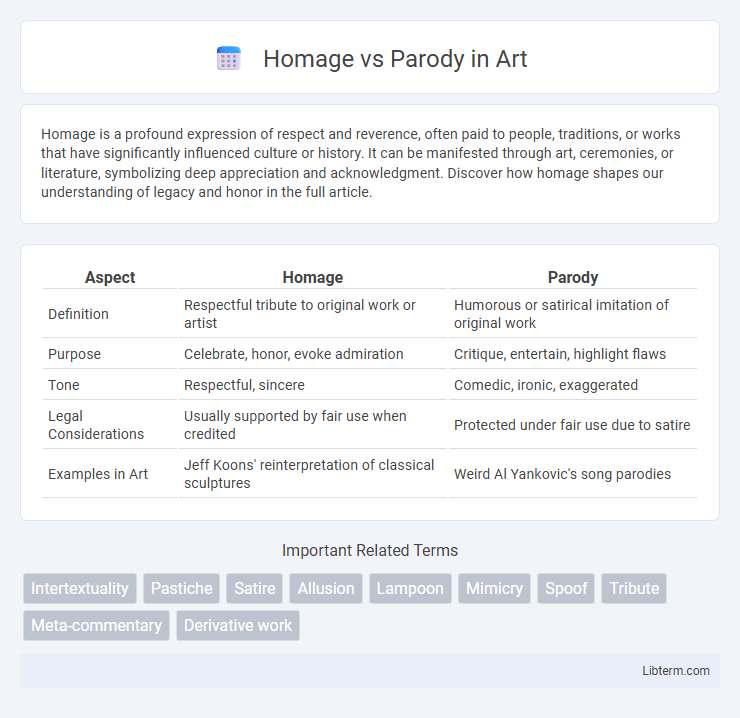Homage is a profound expression of respect and reverence, often paid to people, traditions, or works that have significantly influenced culture or history. It can be manifested through art, ceremonies, or literature, symbolizing deep appreciation and acknowledgment. Discover how homage shapes our understanding of legacy and honor in the full article.
Table of Comparison
| Aspect | Homage | Parody |
|---|---|---|
| Definition | Respectful tribute to original work or artist | Humorous or satirical imitation of original work |
| Purpose | Celebrate, honor, evoke admiration | Critique, entertain, highlight flaws |
| Tone | Respectful, sincere | Comedic, ironic, exaggerated |
| Legal Considerations | Usually supported by fair use when credited | Protected under fair use due to satire |
| Examples in Art | Jeff Koons' reinterpretation of classical sculptures | Weird Al Yankovic's song parodies |
Understanding Homage and Parody: Key Differences
Homage involves respectfully acknowledging and celebrating the original work, often replicating style or elements to honor its influence, while parody intentionally exaggerates or mocks those aspects for comedic or critical effect. The key difference lies in intent: homage seeks to pay tribute and show admiration, whereas parody aims to entertain through satire or critique. Both use recognizable references, but homage fosters appreciation, whereas parody challenges or lampoons the source material.
The Origins of Homage and Parody in Art and Media
Homage originated as a respectful acknowledgment or tribute to a preceding artist or work, often manifesting through direct references or stylistic imitation in visual art, literature, and film. Parody emerged from the tradition of satire and comedic imitation, aiming to mock or critique the original work by exaggerating its distinctive features for humorous or critical effect. Both forms trace their roots to classical antiquity, where playwrights and poets employed mimicry to honor or lampoon established works, establishing the foundational practices of homage and parody in artistic expression.
Intentions Behind Homage vs Parody
Homage intends to show respect and admiration by subtly referencing or paying tribute to the original work, highlighting influence and inspiration. Parody aims to use humor, satire, or exaggeration to critique or mock the original, often emphasizing its flaws or absurdities. Understanding these intentions clarifies the creative goals and emotional responses each approach seeks to evoke.
Recognizing Homage: Subtlety and Reverence
Recognizing homage involves identifying subtle references that demonstrate respect and admiration for the original work, often through nuanced visual or thematic elements. Unlike parody, which relies on exaggeration and humor to critique, homage maintains a tone of reverence and fidelity to the source material. Key indicators include faithful replication of stylistic details and the absence of satirical intent.
Spotting Parody: Satire, Humor, and Critique
Spotting parody involves recognizing its use of satire, humor, and critique to exaggerate or mock original works, often highlighting societal flaws or cultural issues. Unlike homage, which respectfully honors the source material, parody employs irony and caricature to provoke thought and entertain by exposing absurdities. Effective parody blends comedic elements with pointed commentary, making it a powerful tool for social and artistic criticism.
Legal Considerations: Copyright Implications
Homage and parody differ significantly in copyright law, with parody often protected as fair use due to its critical or humorous commentary on the original work. Homage, while paying respect or tribute, may risk copyright infringement if it reproduces substantial elements without permission. Legal considerations require analyzing the purpose, amount, and market effect of the use to determine whether homage crosses into unauthorized copying or qualifies as transformative parody.
Cultural Impact of Homage and Parody
Homage and parody both significantly shape cultural narratives by engaging audiences in distinct ways; homage honors and preserves influential works, reinforcing shared cultural values and collective memory. Parody, through satire and exaggeration, challenges societal norms and stimulates critical reflection, often serving as a catalyst for social change. Together, they foster cultural dialogue by blending reverence and critique, expanding the boundaries of artistic expression.
Notable Examples in Film, Literature, and Music
Notable examples of homage in film include Quentin Tarantino's "Kill Bill," which reverently references classic martial arts cinema, while parody is exemplified by Mel Brooks' "Blazing Saddles," spoofing Western genre conventions. In literature, James Joyce's "Ulysses" pays homage to Homer's "Odyssey" through its modernist retelling, whereas Terry Pratchett's "Discworld" series parodies traditional fantasy tropes with satirical humor. Music features homage in Madonna's "Vogue," inspired by 1920s jazz culture, contrasted with "Weird Al" Yankovic's parody songs that mimic popular tracks with comedic lyrics.
Audience Perception: Reception and Misinterpretation
Audience perception of homage often involves appreciation for respectful tribute and recognition of the original work's influence, leading to positive reception among fans familiar with the source material. Parody, designed to invoke humor or satire, may be misinterpreted as offensive or disrespectful, especially if viewers lack context or familiarity with the subject being mocked. Misinterpretation arises from the audience's differing cultural backgrounds, knowledge levels, and expectations, affecting whether homage is seen as flattery or parody as ridicule.
Choosing Between Homage and Parody in Creative Works
Choosing between homage and parody in creative works depends on the creator's intent and audience reception. Homage involves respectful imitation that honors and celebrates the original, often enriching the narrative by referencing iconic elements subtly. Parody employs satire or exaggeration to critique or humorously reinterpret the source, requiring careful balance to avoid legal issues related to copyright infringement.
Homage Infographic

 libterm.com
libterm.com